The Best New York Style Pizza Dough and 14 Tips for Success!!
I’ve been making a lot of this NY style pizza dough recipe …. The obsession started a while back, and I’ve finally found a recipe that I love the best! After years of experiments (and I mean years!), I am now using this recipe based on recommendations from the many fine pizza makers at www.pizzamaking.com and the late great Dough Doctor, Tom Lehmann.

Making Pizza Dough at Home
Making NY style pizza dough is definitely somewhat of an art form. There are so many variables that can be changed aside from the ingredients alone. For example, these variables include:
- oven temperature
- temperature of the water used to make the dough
- proofing methods (room temp vs cold rise)
- order of adding the ingredients (yes, this makes a big difference!)
- mixing time
- use of autolyse
- use of poolish (I don’t do this or the one before, although I have in the past)
And then of course, the toppings which can be simple or as complex as you’d like. But don’t worry too much about all of this – my method is easy and straightforward. Plus, you will make better dough than 99% of the pizza chains out there. You will not want take out anymore!
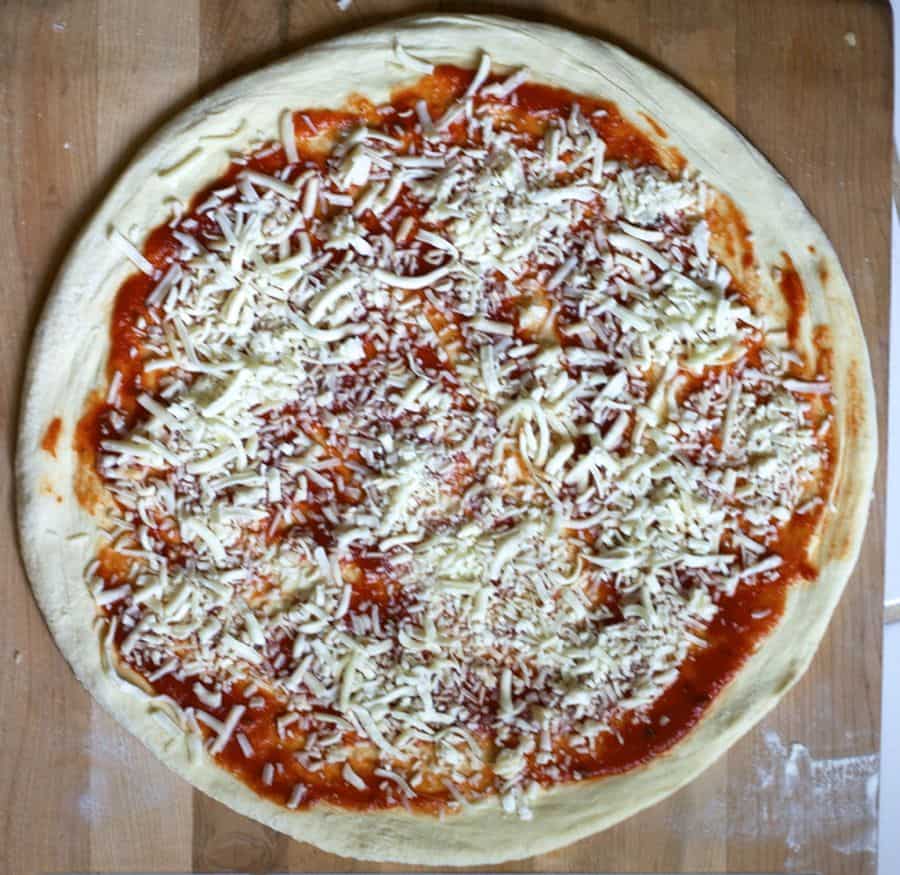
My Favorite Pizza Dough: The Big Secret (How You Proof the Dough)
My all-time favorite dough is NY style dough, which really is classic pizza dough that is stretched out into a thin crust pizza. This type of pizza dough contains water, flour, salt, instant yeast, and olive oil (and sugar especially when baking in a home oven, to help browning).
After it is mixed, it is proofed (left to rise/ferment) in the refrigerator for a minimum of 24 hours and up to 72 hours (it can also be frozen) – this is the big secret. I’ve used the dough up to 5 or 6 days afterwards, so you can essentially prepare dough for the week.
This recipe produces a crisp yet foldable crust that is tender, light, and flavorful and will make enough for four 14-inch pizzas. You can easily double or half the recipe to make 2 or 8 pizzas.

Fourteen Tips for Success
Tip 1: Choosing the flour
Use high-quality flour – I like to use King Arthur’s all purpose or bread flour; higher protein (ie, bread) flours work best. However, I prefer all-purpose flour because I like a lighter, airy crust.
Tip 2: Adding the yeast
Do not add instant dry yeast (IDY) directly to cold or cool water – you may shock the yeast (add the IDY to your flour instead) (please note that IDY differs from active dry yeast, which must be activated by adding it to water).
Tip 3: How much yeast?
Use only enough yeast to “get the job done” – yeast eats the sugar in your flour to produce its leavening effects – I find that if you use too much, your dough will be tasteless (this is just my opinion); however, it is a fact, that too much yeast can make your dough taste bad. Most recipes out there, some of them in well known, published books contain too much yeast!
Tip 4: Cold ferment that pizza dough!
Always use your refrigerator. The best NY style doughs “ferment” or “cure” in the refrigerator for at least 24 hours and up to 48 72 hours. This is called a “cold rise” (vs warm rise on your kitchen counter).
The refrigerator is used to retard (or slow) the dough’s fermentation, allowing that distinctive flavor to come through (ever wonder why some pizza crust tastes different than others, despite the fact that they are both made from just about the same exact ingredients? – this is a big reason why!)
When your dough rises too quickly, the flavor will not develop optimally. Slow rise = MUCH better flavor.
Tip 5: Weigh those ingredients!
Use a scale to weigh the flour instead of using a measuring cup – it is much more accurate and will yield superior results. I’ll admit, I resisted doing this for a loooong time. Just do it. You’ll be glad you did and your dough will be more consistent and much improved.
Tip 6: Add oil last
Mix the oil in as the last step, after the flour has all been incorporated. This is important to allow the flour to hydrate properly.
Tip 7: Flour your dough balls
Before tossing or opening your dough balls, flour them *very* well on each side (if you are a beginner) to ensure they do not stick to your counter or pizza peel. I sometimes use a bit more flour after I begin spreading them.
Tip 8: Keeping those rims a bit puffy
Take care not to “degas” the rim of your pizza as you are spreading your dough! Do NOT ever use a rolling pin! There are many different methods to spread/open your dough ball. I hope to add a few pictures someday of this process.
Tip 9: Baking pizza in a home oven
Ensure that your oven is preheated for a sufficient amount of time (about 1 hour) and bake the pizza within 6 to 8 inches of the top of your oven (ie, your broiler) so that the tops browns sufficiently in conjunction with the bottom of the pizza.
Do not place the stone near the bottom of your oven. I made this mistake for too many years.
After your stone has been preheated sufficiently, the heat from the stone will cook the pizza from the bottom and you can switch the broiler on if you find you need more browning on the top (I now use the broiler to bake my pizzas…more on this sometime in the future).
If you find that your cheese is browning well before your rim attains sufficient color, use partially frozen cheese (ie, place shredded cheese in the freezer while the oven is heating up) and cold sauce or you can drizzle just a bit of olive oil on top of cheese.
Tip 10: Use a pizza stone or steel
Use a pizza stone if you have one. The stone with draw moisture out of the dough and produce a beautifully crisp crust. I use a pizza steel because my stones kept breaking.
Tip 11: Use just the right amount of sauce
Do not use too much pizza sauce – it will make your pizza soggy
Tip 12: Find the right kind of cheese
Do not use low fat cheese to top your pizza or pre-shredded cheese (the former will not melt sufficiently and the latter contains additives that prevent the cheese from sticking together and therefore does not melt very well). The best is low-moisture, whole milk mozzarella.
If you must use pre-shredded cheese, I’ve found that adding the sauce on top of the cheese helps with the melting. Also, do not use too much cheese; apply it sparingly so that you can achieve that mottled NY pizza appearance.
Tip 13: Flour your pizza peel
Use semolina or flour on the bottom of your pizza peel to prevent the pizza dough from sticking but be careful not to overdo it because it will burn.
Tip 14: Learn to launch that pizza
Give the pizza peel a few very small quick jerks to make sure the pizza will easily slide off your pizza peel before attempting to transfer pizza to the oven, and more importantly, rub flour into the peel before placing the dough on top.
Essential Equipment
Please note that as an Amazon affiliate, we earn a small commission if you purchase a product at no additional cost to you.
I adore my baking steel; it’s transformed my home pizzas into restaurant-quality and better. You will love this! A kitchen scale streamlines measurement with remarkable accuracy, while a pizza peel is essential for smoothly sliding pizzas into the oven. And proofing boxes provide an optimal storage for pizza dough fermentation, enhancing flavor, texture, and elasticity.
Please visit our SHOP page for more recommended tools and equipment to make restaurant-style NY-style pizza at home!
How to Stretch the Pizza Dough
A nice video (from The GoodFellas Pizza School of NY), showing how to stretch the dough:

How to Freeze Homemade Pizza Dough
- After mixing dough and dividing into balls, place dough in refrigerator for at least 24 hours.
- Place dough balls on baking sheet lined with plastic wrap or parchment paper, cover loosely with plastic wrap and freeze until firm (~ 2 to 3 hours or up to overnight).
- Wrap frozen dough balls individually in plastic and store in zipper-lock bags for up to 4 weeks.
- When ready to bake, transfer unwrapped dough into the refrigerator for 12 to 24 hours before making pizza.
- Bring dough to room temperature for 20 to 60 minutes before baking (less time for hot kitchen/summer and more time for cool kitchen)
Pizza Dough Calculator
Need more dough? Less dough? Try out our new Pizza Dough Calculator to calculate the weights to get it just right!
Have More Questions?
Please See My NY Pizza FAQ
If you tried this recipe, please leave a 🌟 star rating and let me know how it went in the 📝 comments below! SUBSCRIBE for more recipes.
📖 Recipe

The Best New York Style Pizza Dough
Equipment
- pizza stone or pizza steel for baking
- Standing mixer optional or hand knead
- kitchen scale highly recommended instead of volume measures
Ingredients
Original Recipe for Four 14-Inch Pizzas; want to make more or less? Use the pizza dough calculator
- 6.5 cups (796 g) all purpose flour or bread flour (weighing is most accurate!)
- 2 1/4 cups (493 g) water barely cold water (17.4 oz per 2 1/4 cups)
- 1 teaspoon (3.5 g) instant dry yeast
- 2.5 teaspoons (15.6 g) salt
- 2 teaspoons (7.8 g) sugar
- 1 tablespoon (11.8 g) olive oil
1 Pound of Dough (~454 grams) (use the pizza dough calculator to make more or less dough)
- 2 1/4 cups (274.5 g) all purpose flour or bread flour
- 3/4 cup (170.2 g) water
- 1/2 teaspoon instant dry yeast
- 1 teaspoon salt
- 3/4 teaspoon sugar
- 1 teaspoon olive oil
Instructions
Mixing the Dough
- Place water in mixing bowl.
- In a separate bowl, mix salt and yeast (and sugar if using) into flour
- Combine flour/salt/yeast mixture into water and mix until all the flour has been incorporated.
- After flour has been totally incorporated, add oil and knead for about 4 to 5 minutes (see note)
- Test final dough temperature, which should ideally be between high 70s to low 80s (optional)
Dividing and Rising
- Divide dough into 4 equal pieces (using a digital scale if possible; each ball should weigh 11.5 oz [~326 grams]), shape into a ball, and place in greased, sealed quart-sized container or oiled/greased freezer bag and refrigerate overnight or up to 72 hours (After much experimenting, I have concluded that I like 3 days best but day 2 is good too).
Assembly and Baking
- The following day, remove your dough balls within 1 hour or less of baking and allow the dough to come to room temperature. (the dough will tend to blister more if the dough has not been allowed to come to room temperature however, I often bake coldish dough without problems, just some bubbling)
- In the meantime, place your pizza stone in oven and preheat at 550 degrees (depending on thickness of your stone and your oven’s power) for at least 1 hour
- Open each dough ball using care not to degas, transfer to a pre-floured pizza peel (or on parchment paper), and top with your favorite sauce, cheese, or other toppings.
- Transfer pizza from peel to oven or slide parchment paper onto preheated pizza pan/stone and bake for 4 to 6 minutes each until browned on top and cheese has melted but not burned.
- Enjoy!
Notes
- Use of weight based measurements is highly recommended instead of US Customary. You will need a kitchen scale.
- METRIC amounts DO NOT correspond exactly to the US Customary amounts because, for example, 796 grams equals 6.4 cups (and most can’t measure 0.4 cups or 0.22 cups). Recipe was based on grams.
- Use the Pizza Dough Calculator
- If you want to use the dough the next day, knead a little more (slow speed for about 8 to 10 minutes)
- If you have time to let the dough rest for 3 days, knead for 4 to 5 minutes, low speed or hand knead.
- After mixing dough and dividing into balls, place dough in refrigerator for at least 24 hours.
- Then, place on baking sheet lined with plastic wrap or parchment paper, cover loosely with plastic wrap and freeze until firm (~ 2 to 3 hours or up to overnight).
- Wrap frozen dough balls individually in plastic and store in zipper-lock bags to store for up to 4 weeks (longer may work, but results might vary).
- Before using, transfer unwrapped dough into the refrigerator for 12 to 24 hours before making pizza.
- Bring dough to room temperature for 20 to 60 minutes before baking (less time for hot kitchen/summer and more time for cool kitchen).
- calculate your own using baker’s percentages: 62% hydration, 0.4% yeast, 2% salt, 1.5% oil, and 1% sugar or use my new pizza dough calculator.
Nutrition
Try these other pizzas and this NY pizza sauce:
Buffalo style (one of my absolute favorites)
White with prosciutto
White with spinach and feta
Pizza sauce

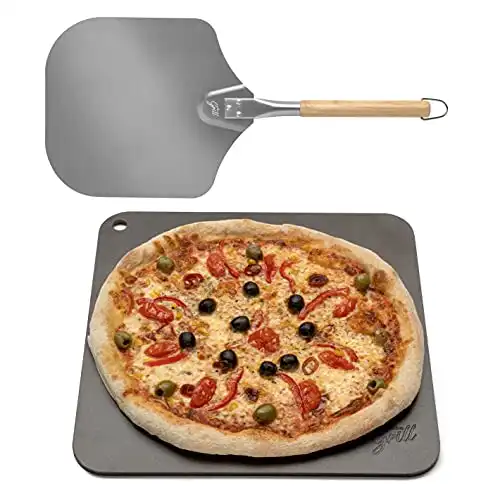
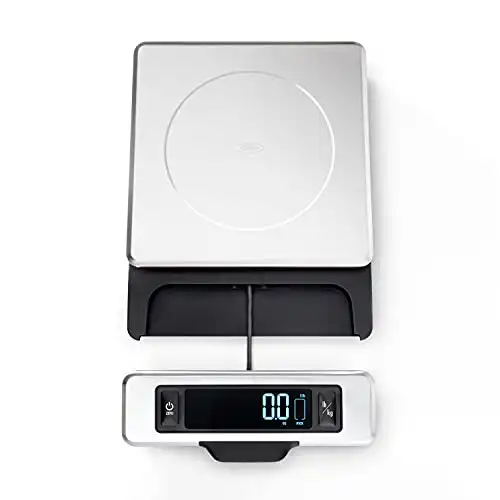
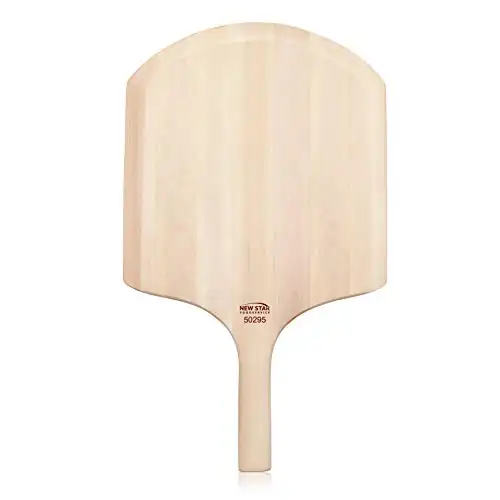
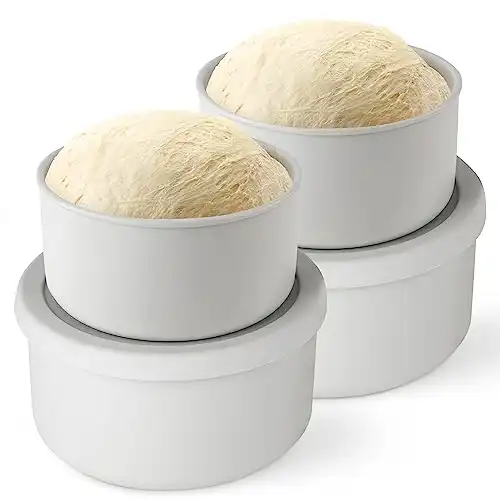
Could you please elaborate on the best way to freeze and thaw this dough. Thank you.
I put each dough ball in its own freezer bag (quart sized) and then take out of the freezer the morning I want to use. Place in fridge to thaw and then place on counter about an hour before you plan to use to allow the dough to get to room temp. You’ll need a bit of extra flour to coat the defrosted dough because the freezer will add moisture and make it more sticky. I’m not sure how long the dough will last in the freezer because I go through it pretty quickly. I should be fine for at least a month.
My dough is rising in the frig. Today is the third day when I take the four bags of pizza balls out to make pizza. Once the pizza balls have been in the frig for three days can I freeze the ones I don’t want to use?
Yes, I’ve done that…just take out of freezer morning u want to use and then out of fridge an hour before. Flour lightly so not too sticky
I just made this tonight and had a flashback to my youth in Westchester. I have been trying for years to make something even remotely close to home and you just did it for me. I used active dry yeast since its what I had on hand. For whatever reason I only got 3 pizzas but I think my scale may need a battery. i baked it on my faux stone aka terra cotta plant saucer from Lowes. topped with my homemade mozzarella. My family devoured it!
Hi Leah – that’s great to hear! Enjoy:)
Looks great but for non American visitors the measurements are a nightmare to follow. You even stress the importance of using using the scale to weight the ingredients then give us the recipe with all those oz. and cups and such. Why? Can you give us the recipe in grams and ml? I mean you even end up with “Weighing the flour is *highly* recommended. Using a cup to measure will typically yield inaccurate results, plus different flour brands have different weights ” then go against it by not giving us grams and ml so we can properly measure it. Thanks 🙂
Hi Mike, I will add grams and mls. I use the scale to weigh in oz, not grams, but my scale can also be used in grams. Thank you for letting me know!
Hi Marie,
Just to let you know that I tried your dough recipe and it was delish. Also, I wanted to give a tip on how to get the pizza off the peel. Lift the dough a little and blow between the dough and the peel. The pizza will float off the peel.
Don
thank you, Don!
Oh, sorry, found it. Thickness Factor, which according to the pizzamaking.com people is the area of pizza / ounces of dough. For NY style they say .065 to .085. But they also say many NY go over 1.0. Yours would be .07 for a 14″, .85 for 12″, perfect for NY pizza according to them.
What is the TF of this ?
What weight to use for a 12″ pizza?
Thanks!
I’m not sure what you mean by TF? You can use 11 oz for 14 inch or 12 inch – it will be just a little bit thicker but still keeps with NY style.
Dear Marie,
Should the dough rise first at room temp and then put in fridge, or should it rise in the fridge, or should it rise @ room temp after 72 hours refrigeration?
Besides what should be the temp of the fridge and that of the dough, I tried cold rising @ 38*F but the dough didn’t rise. Is flavor produced even without dough raising in the fridge? Is dough rising just mecanic, doesnt have anything to do with flavor? I use sourdough not idy. I experiment with Napoletana dough, no sugar no oil, just basic ingredients, 330 cl water, 500 g 00 flour, 1.5 t spoon salt, 1/4 cup sourdough, autolyse.
Please help
George
Hi George – I usually place it in the refrigerator directly after mixing. I do that when I plan to use it on day 2 or 3 after mixing. When I want to use it the next day, I will let it rest on the counter for about an hour and then put in the fridge. Either way, I always let it get to room temperature before baking (take it out of fridge an hour or so before baking). I don’t measure the fridge or cold dough temp. The dough does not rise substantially – you probably wouldn’t notice much but it does bubble in bit underneath (you can see if you put in plastic bag or container). The flavor is from the cold rise in the refrigerator, so not the same using warm rise, but many do it this way and love it. See what you prefer. I don’t have much advice for using the starter (sourdough) – you might want to pop over to pizzamaking.com and see if they can help. They have a forum for Neapolitan pizza.
OK, nice suggestions. I will ratio my dough weight per your 14″ ratios, to my 12″ pizza tonight.
The problem with cooking too much is I cook until crust bottom is right crisp/color, so I need more heat probably, so maybe I need the steel plate. I ordered a cast iron pizza plate yesterday, so will do that when it gets in. Maybe use both steel and stone?
OK, your sauce thickness appears to be what mine was. Funny, I saw your sauce recipe on youtube this morning and was wondering about rosemary, I WILL LEAVE IT OUT.
What about garlic? I think no. I used onion powder, it was good. What you think?
What about oregano, thyme, fennel?
I understand shredded cheese has anti sticking agents, that may be undesireable?
thanks
More heat- yes. You r trying to cook as fast as possible. I don’t think u need steel and stone. One or other. The sauce recipe is not mine. I don’t use tomato paste. It was just a suggestion since u stated that u used it in prior recipe. Only a littl oregano since it is strong and basil in season. No thyme rosemary or any other herb for traditional sauce. Garlic yes and onion is optional. Pre-shredded cheese has given me a problem but infrequently. It’s worth a shot. Very convenient and tasty combinations out there!
Well so much for me not posting…We baked a pizza last night with your dough at 48 hours (fermented in fridge). Wife says it’s the best crust she has ever had. I agree. Only issue – bottom was crisp, inner was chewy, but not fold-able like I remember NY pizza to be, AND thicker crust than NY pizza I know. Suggestions?
Other issue, my “mess on top” is still there, we think because we are using the wrong cheese, it is 4% moz, but maybe wet. We will use 2% moz, drier hopefully tonight on a 72 dough. I need help with cheese please?
Baked it on a stone, pre heated at bottom.
I made sauce with tomato paste, water and some spices. Pretty good, I was able to control the water/thickness that way with paste, kept it on the thick side as not to soggy up top dough. Any recipes on sauce with paste?
Thanks!
Glad to hear that it’s coming along If your pizza isn’t foldable, it could be that it’s baking too long, causing it to dry out too much and also too thick as you suggest. I use 11 oz of dough and stretch to 14 inches – this will give you an ideal thickness.
Regarding cheese, try some pre-shredded combinations from the supermarket that are labeled pizza cheese. This conflicts with my blog post, but I’ve had a lot of luck lately with them. It sounds like you might be using too much sauce and cheese to end up with soupy mess. I use a ladle-full of sauce for a 14 inch pizza, which is exactly 1/2 cup. It doesn’t seem like a lot but you don’t need more. The sauce should be thin enough to spread easily but thick enough to coat the back of a wooden spoon. Cheese amount is harder, cause I do it by sight.
I don’t use tomato paste, but you can try this: http://allrecipes.com/recipe/easy-pizza-sauce-i/ The one thing I would absolutely change is not to add rosemary to my pizza sauce (bleck!)
Hi Marie,
I’m excited to try this dough recipe. I do have a question about a substitution though… if I were to use Active Dry Yeast instead of the Instant Yeast, how would the process differ in the recipe instructions? And would the water that I use to proof the active yeast be subtracted (or taken from) from the total amount of water in the original recipe?
Thanks
Use the same amount of active dry yeast as the recipe calls for – you can mix it in some of the water first to hydrate it (water should be about 100 degrees in temp/lukewarm, but not too hot or you’ll kill the yeast). And, yes – subtract that amount of water from the total needed.
And maybe my dough was dry because I used a high gluten/high protein/higher dense flour, King Author Bread flour, maybe needing more water in dough.
You have a good point, but again it’s all relative to what you’re used to. I will post more photos one of these days and hopefully it will clarify my process at least
OK, my last post for awhile as not to dominate this blog and take advantage of your generous responses.
1. The cast iron pizza pan is flat, allowing direct transfer to the “plate”, no sides.
Google “Logic Pro Classic Cast Iron Pizza Pan”. I will buy and try when I start
making decent pies. Mine are terrible now.
2. I cooked a sauce, popular recipe, last night. Not very good, will try no cook, set in
fridge.
3. I will try the $99.00, 750 F oven, and separately a plate of 1/4″ steel, also when my
pies are non terrible.
A psychiatrist once told me you have to be somewhat compulsive to be an degreed engineer. I least I know why, ha!
Thanks
When I buy a stone, it must be at least 2 inches bigger than my pizza to allow space for transfer. Just a factor to consider when you are purchasing. Everyone’s technique is different i’m sure but I need at least a 2inch buffer (16 inch square stone for 14 inch pizzas) I wish I could bake larger pizza but my oven too small.
Keep in mind that the MOST important part of the sauce recipe is finding a tomato brand that is good. Hands down this is key, cooked or not cooked.
Curious about a $99 dollar oven that gets to 750 degrees..almost sounds too good to be true?
Your article here is wonderful. Thank you.
We processed the dough last night and set it in the fridge. We will try one tonight (24 hours) one Friday ( 72 hours).
Questions:
1. The dough seemed dry, is this normal?
2. After 12 hours in fridge, there seems to be very little rise. Is this normal? I assume it
is due to two of your rules – cold fridge to slow down fermentation, as little yeast as
possible.
3. Have you used sourdough starter instead of yeast? This is yeast and bacteria ( I
know you know this), where the bacteria releases lactic and acetic acid to add acid to
sour, the yeast is for rising.
4. We use a pizza stone, preheat to 550 F for one hour. However, it takes about 13
minutes to crisp the crust perfect. But the pizza sauce, cheese and some of the
top dough seem to combine for an unpleasant mess on top. I assume not hot
enough, should cook higher temp, lower time, but my oven is small. Any suggestions?
5. Have you used dough with larger quantities of oil, or shortening, or even butter?
Seems oil add a rich flavor to about anything. I noticed a local “NY Style” pizza shop’s
crust has that “Crisco” smell to it. I easily notice this smell, Crisco when heated has a
very ” plastic” or artificial smell to me, however, it taste good and makes very crisp
crust.
6. Do you have an equivalent NY style sauce recipe?
Thanks!!!!!
Hello,
To answer your questions: 1. No, my dough doesn’t seem dry but it is all a matter of opinion – maybe it’s dryer than what you are used to?
2. Yes, very little rise is normal. 3. Yes, I’ve used starter and loved it but found that it was too much work to reactivate the starter every week, wait for it to rise, and then make the dough 4.I used to have the same problem. Top would cook before bottom so I moved the pizza to the top of the oven and it helps a lot! Some people even switch on the broiler after the oven has heated since at that point, the bottom is cooked from the heat of the stone. You have to play around a little with what works for you. 5. I haven’t played around with different quantities of oil, but one of my favorite NJ shore pizza places supposedly uses shortening and their pizza is awesome. 6. I have a NY pizza sauce recipe – you have to scroll up through the comments – I will list it some day soon. I use tomato puree, thin with a little water and add oregano, salt, pepper, sugar, garlic, olive oil, pinch of red pepper flakes and fresh basil is great if you have any.
Item 4, pizza top is a burnt mess. I did have the pizza stone at top of oven. I am thinking the absorbed radiant heat at the top surface of oven is doing this, I pre heated the stone/oven for 1 hour. I will try putting the stone at the bottom.
Also:
1. Do you pre cook your pizza sauce?
2. I read where the NY style pizzas are usually cooked at lower temperature, in the
400 F’s. Do you agree? Where the Neapolitan style are in the 700 to 900 range.
3. There are some small electric counter top pizza cookers that claim to get to over
700 degrees, a heating element on top, and on bottom, and one pizza stone.
Cooks in only 3 to 7 minutes. Looks almost like a waffle cooker. Any
knowledge/comments of/on these?
4. What cheese to you recommend? Dry? Sliced? 4%, 2%……?
5. I read to put the pizza stone at the top and turn on the broiler high to get the
stone hotter. I did and my top was burnt before crust was crisp, comments?
6. Do you have comments on a cast iron pizza pan?
Sorry if I ask too many questions, the engineer in me.
Thank you
Hi Philip – uh oh! Your strategy sounds great. Exactly what I would do.
1. I have often read that NY pizza sauce is not precooked, and so I don’t do it (I have done it before so really it’s a matter of taste, but it’s not necessary). It is more critical to combine the ingredients beforehand and let the flavors marry by letting the sauce sit in the refrigerator for at least a few hours.
2. My favorite pizza place in NJ will vary the oven temp depending on the outside temp. I have seen them cook the pizza from high 400s to low 500s depending on ambient room temp etc. I’m not that advanced to make suggestions based on weather but point is, yes – you are correct, high 600 and 700s for Neopolitan and lower for NY style. Some advanced pizza makers will insist though that the best homemade crust must be cooked within 6 minutes or so or you run the risk of having a dried out crust
3. No idea but would be interesting in hearing if they work. I’m about to try cooking on a steel plate http://slice.seriouseats.com/archives/2012/09/the-pizza-lab-the-baking-steel-delivers.html I special ordered mine, but word is that you can get one for much cheaper if you live near a steel fabrication business.
4. I like combining a lot of different cheeses. While milk, low moisture mozz, of course. Sometimes grated parmesan and I also love mild white cheddar in the mix (I’m sure I’d hear of lot of arguments over that one, but the flavor is awesome in my opinion).
5. All I can say is that everyone’s oven runs differently and unfortunately, you have to play around with what works for you. Ur strategy to lower the shelf is spot on.
6. I’ve tried it and liked it (a while ago), but I like to transfer my pizzas directly onto a hot surface (stone, steel plate) so that would be impossible with a cast iron pan. Good for an alternative though!
I am rookie but after reading the reviews and watching your video, I think I can do this! I am using a pizza stone to make the pizza in a conventional oven. Do I need to use parchment paper with the pizza stone?
you can use the parchment paper if you don’t feel confident enough to transfer the pizza directly from the pizza peel onto the stone..
thank you so much Marie. It turned out really good!!
great!!